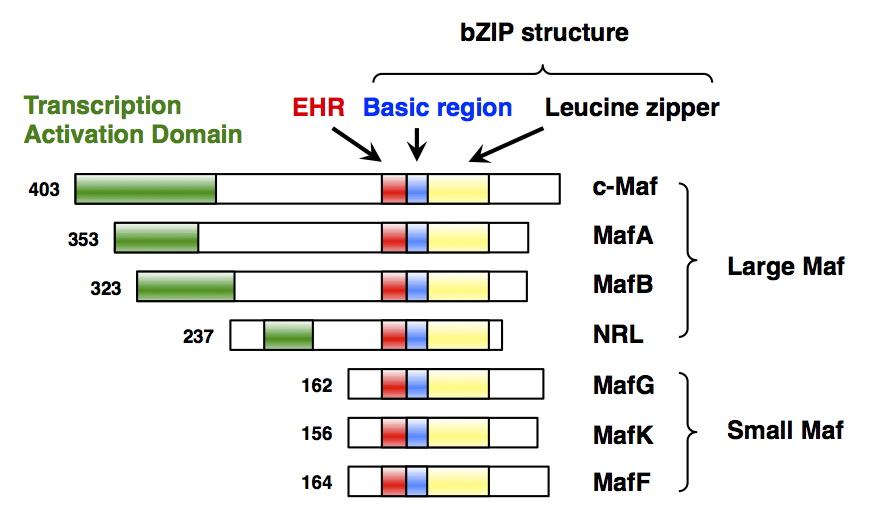MAFF (gene) on:
[Wikipedia]
[Google]
[Amazon]
 Transcription factor MafF is a bZip Maf
Transcription factor MafF is a bZip Maf
 Transcription factor MafF is a bZip Maf
Transcription factor MafF is a bZip Maf transcription factor
In molecular biology, a transcription factor (TF) (or sequence-specific DNA-binding factor) is a protein that controls the rate of transcription of genetic information from DNA to messenger RNA, by binding to a specific DNA sequence. The f ...
protein
Proteins are large biomolecules and macromolecules that comprise one or more long chains of amino acid residues. Proteins perform a vast array of functions within organisms, including catalysing metabolic reactions, DNA replication, res ...
that in humans is encoded by the ''MAFF'' gene
In biology, the word gene (from , ; "...Wilhelm Johannsen coined the word gene to describe the Mendelian units of heredity..." meaning ''generation'' or ''birth'' or ''gender'') can have several different meanings. The Mendelian gene is a b ...
.
MafF is one of the small Maf proteins, which are basic region and leucine zipper
A leucine zipper (or leucine scissors) is a common three-dimensional structural motif in proteins. They were first described by Landschulz and collaborators in 1988 when they found that an enhancer binding protein had a very characteristic 30-amin ...
(bZIP)-type transcription factors. The HUGO Gene Nomenclature Committee-approved gene name of ''MAFF'' is “v-maf avian musculoaponeurotic fibrosarcoma oncogene homolog F”.
Discovery
MafF was first cloned and identified in chicken in 1993 as a member of the small Maf (sMaf) genes. MAFF has been identified in many vertebrates, including humans. There are three functionally redundant sMaf proteins in vertebrates, MafF,MafG
Transcription factor MafG is a bZip Maf transcription factor protein that in humans is encoded by the ''MAFG'' gene.
MafG is one of the small Maf proteins, which are basic region and leucine zipper (bZIP)-type transcription factors. The HUGO Ge ...
, and MafK.
Structure
MafF has a bZIP structure that consists of a basic region for DNA binding and a leucine zipper structure for dimer formation. Similar to other sMafs, MafF lacks any canonical transcriptional activation domains.Expression
''MAFF'' is broadly but differentially expressed in various tissues. ''MAFF'' expression was detected in all 16 tissues examined by the human BodyMap Project, but relatively abundant in adipose, colon, lung, prostate and skeletal muscle tissues. Human ''MAFF'' gene is induced by proinflammatory cytokines, interleukin 1 beta and tumor necrosis factor in myometrial cells.Function
Because of sequence similarity, no functional differences have been observed among the sMafs in terms of their bZIP structures. sMafs form homodimers by themselves and heterodimers with other specific bZIP transcription factors, such as CNC (cap 'n' collar) proteins 45_NF-E2_(NFE2),_Nrf1_(NFE2L1.html" ;"title="NFE2.html" ;"title="45 NF-E2 (NFE2">45 NF-E2 (NFE2), Nrf1 (NFE2L1">NFE2.html" ;"title="45 NF-E2 (NFE2">45 NF-E2 (NFE2), Nrf1 (NFE2L1), Nrf2 (NFE2L2), and Nrf3 (NFE2L3)] and Bach proteins (BACH1 and BACH2).Target genes
sMafs regulate different target genes depending on their partners. For instance, the p45-NF-E2-sMaf heterodimer regulate genes responsible for platelet production. Nrf2-sMaf heterodimer regulates a battery of cytoprotective genes, such as antioxidant/xenobiotic metabolizing enzyme genes. The Bach1-sMaf heterodimer regulates the heme oxygenase-1 gene. In particular, it has been reported that MafF regulates the oxytocin receptor gene. The contribution of individual sMafs to the transcriptional regulation of their target genes has not yet been well examined.Disease linkage
Loss of sMafs results in disease-like phenotypes as summarized in table below. Mice lacking MafF are seemingly healthy under laboratory conditions. However, mice lacking MafG exhibit mild neuronal phenotype and mild thrombocytopenia, mice lacking ''Mafg'' and one allele of ''Mafk'' (''Mafg−/−::Mafk+/−'') exhibit progressive neuronal degeneration, thrombocytopenia and cataract, and mice lacking MafG and MafK (''Mafg−/−::Mafk−/−'') exhibit more severe neuronal degeneration and die in the perinatal stage. Mice lacking MafF, MafG and MafK are embryonic lethal, demonstrating that MafF is indispensable for embryonic development. Embryonic fibroblasts that are derived from ''Maff−/−::Mafg-/−::Mafk−/−'' mice fail to activate Nrf2-dependent cytoprotective genes in response to stress. In addition, accumulating evidence suggests that as partners of CNC and Bach proteins, sMafs are involved in the onset and progression of various human diseases, including neurodegeneration, arteriosclerosis and cancer.See also
*MAF (gene)
Transcription factor Maf also known as proto-oncogene c-Maf or V-maf musculoaponeurotic fibrosarcoma oncogene homolog is a transcription factor that in humans is encoded by the ''MAF'' gene.
Types
One type, ''MafA'', also known as ''RIPE3b1'', pr ...
Notes
References
Further reading
* * * * * * * *External links
* * {{Transcription factors, g1 Transcription factors